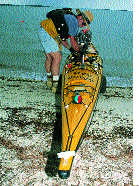

November/December
2001
 Paddle
Power
Paddle
Power
The peaceful approach to exploring the waterways
Of all the
ways to get out and experience our watery paradise, nothing compares to
canoeing or kayaking.
Heralded as “zero impact” sports, these are the most environmentally
sound ways of traversing the waterways. Noiseless and close to the water,
they offer the best chances to get up close and personal with the marine
ecosystem and wildlife. Curious dolphins surface slowly to look paddlers
eye to eye, while manatees amble alongside without fear of propeller scars
or pounding.
Getting out on the water and paddling also is the best
way to reconnect with the spirit of the indigenous Calusa Indians who
lived in harmony with the local environment for thousands of years. They
relied on dugout canoes, carved out of trees, to travel their territory
from Punta Gorda down to the Keys without disrupting the ecosystem that
supported them.
Archaeologists also suspect that the Calusas were
involved in trading routes that might have taken them as far south as
the Amazon River basin and as far west as the Yucatán in Mexico.
Today, more power boats and personal watercraft are on the water than
ever, but paddlers tend to be the sort of people who are more interested
in seeking peace and quiet than a speedy thrill across the water.
Paddling also is a fabulous exercise—and
one that you can do at your own pace. Cruising quickly provides a great
aerobic, upper-body, and abdominal workout. For the pleasure seeker more
interested in checking out the intricacies of the estuary and river environments,
paddling at a relaxed pace can be meditative and reflective.
Places to paddle along the Lee Island Coast abound.
From creeks in North Ft. Myers, to the grass-flat shallows and mangrove
islands of the Charlotte Harbor estuary, to the more challenging waters
of the Gulf of Mexico, paddlers can find a variety of waterways to experience.
White-water paddling is restricted to rivers farther north and west, but
some good surf skiing is available in the gulf, especially during winter
storms when paddlers put on their wet suits and crash through the waves.
Various outfitters can help you figure out what
you want to experience on local waters.
From Estero River Outfitters (941/992-4050),
located on U.S. 41 in Estero, paddlers can rent various types of canoes
and kayaks. Adventurers can launch from the Outfitters directly into the
Estero River where lush vegetation flows over its banks. Chances are that
the twists and turns of the river will reveal an alligator, blue heron,
or an osprey screeching overhead.
Trips include tours to the Estero Bay Scrub Area,
which highlights the need to protect the river and the estuary it feeds.
Tours also go to the Koreshan Village, a state historical site where pioneers
at the turn of the last century tried to establish a “New Jerusalem.”
A guide also offers in-depth historical tours to Mound Key, the ancient
capital of the Calusa Indians.
Just south of Ft. Myers Beach on Estero Boulevard
is the concession center for Lovers Key State Recreation Area (941/765-1880),
where tours of Estero Bay and Mound Key also are available. Experienced
guides offer adventure paddling tours, including overnight trips to the
state park at Cayo Costa, as well as guided tours of the Everglades. Fishing
enthusiasts can rent canoes outfitted for a full day of fishing in the
bay.
Wild Vision Kayak & Canoe Tours
(941/765-1880), on Estero Boulevard in Ft. Myers Beach, also offers
rentals and tours of the Estero Bay area.
On Sanibel Island, Tarpon Bay Recreation
(941/472-8900), located on the bay at the end of Tarpon Bay Road,
offers tours and excursions through mangrove trails of the J.N. “Ding”
Darling National Wildlife Refuge. Both canoes and kayaks are available
for rent and experienced paddlers are welcome to launch their own vessels.
For tours of the Sanibel River as well as narrated
adventures through the wildlife refuge, former Sanibel Mayor Mark “Bird”
Westall (941/472-5218) is available for bookings. A longtime
resident of the island, Westall specializes in birding and natural history.
On neighboring Captiva Island, paddlers can sign
up with veteran paddler and naturalist Brian Houston for kayaking instruction
and tours of Buck Key. Operating out of ’Tween Waters Inn, Houston’s
tours can be booked by calling Sanibel Sea Kayak Wildlife Tours &
Adventure (941/437-0956).
Also on Captiva, on the bay at the end of Andy
Rosse Lane, Captiva Kayak Company/Wildside Adventures (941/395-2925)
offers one of the most varied and extensive arrays of kayaks for rent
in the area. It features full-moon tours, guided wildlife excursions through
the Pine Island Sound Aquatic Preserve, and tours through the old mosquito
ditches and mangrove trails at Buck Key. Pointed instruction on paddling
techniques also is provided.
For a different view of the local ecosystem, Gulf
Coast Kayaks on Pine Island (941/283-1125), just over the bridge
in Matlacha, offers nature tours through Matlacha Pass. In season, it
also features manatee tours.
Paddlers with their own vessels can experience
the Pine Island Sound Aquatic Preserve by launching from the historic
site at Pineland on the northwest side of Pine Island. Located at the
foot of a 30-foot Calusa Indian shell mound, the launch site ignites an
awareness of the indigenous people.
For a fresher water experience, venture to Arcadia
for the Canoe Outpost on the Peace River (800/268-0083),
where peace and quiet can be discovered far away from the tourist-oriented
gulf coast.
For a good workout or reflective excursion that
leaves the environment at peace, paddle your own canoe or kayak.
Freelance writer and photographer Barbara Linstrom
can sometimes be spotted paddling around Sanibel Island, where she lives
and works.